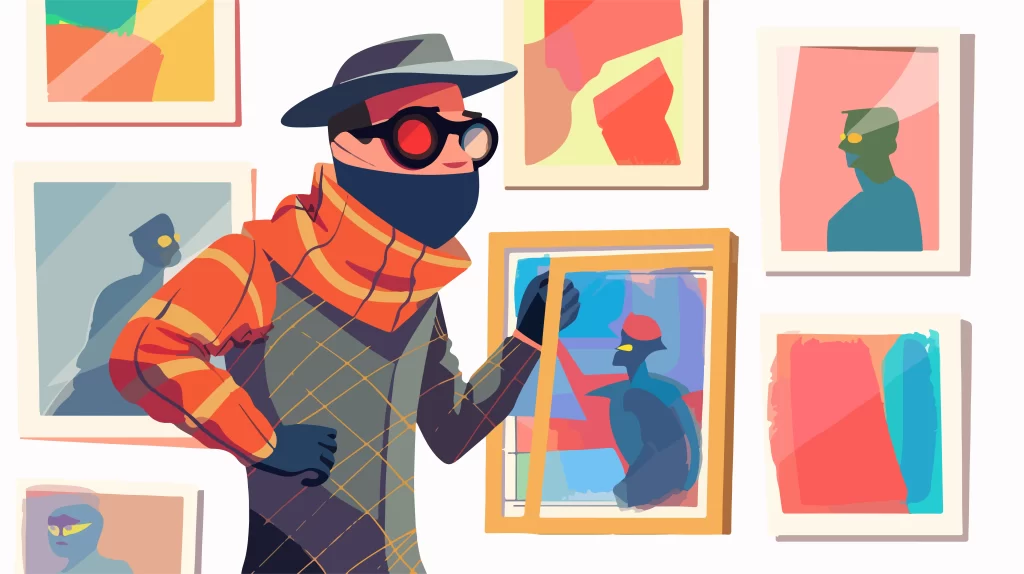- blog14
Mastering Art Protection: The Ultimate Guide to Safeguarding Your Intellectual Property

Securing your creative work in our digital age is more important than ever. Regardless of your medium—painting, design, or photography—your creations are susceptible to theft or mishandling. It is important to understand how to secure your intellectual property (IP) so that the efforts you have put in will be acknowledged, valued, and legally protected. In this guide, we’ll go over the fundamentals of intellectual property art protection and introduce you to a simple fix: Dibs.
Why Does Protecting Your Art Matter?
Artists put their entire being into their creations. But without permission, it’s now simpler than ever for someone to steal, alter, or replicate art, thanks to the internet. Art protection is essential because it safeguards your creative rights and allows you to manage how your work is used, shared, and sold.
By protecting their intellectual property (IP), artists can stop unlawful copies or modifications of their work. Intellectual property rights (IPR) are essential for aspiring and seasoned artists because they guarantee that your creative endeavors are properly credited to you and keep others from unfairly benefiting from your labor.
You also get financial control over your works of art when you protect them. Artists are protected by copyright laws, which allow them to license their creations and profit from commercial use, public exhibitions, and replicas. Your artwork could be exploited in ways you never intended without copyright, weakening your brand or devaluing your creations. Thus, it prioritizes protecting artists’ intellectual property rights.
Ways to Protect Your Intellectual Property as an Artist
There are many methods to protect your intellectual property (IP) as an artist, each offering varying levels of protection:
1. Copyright
Original works of art are automatically protected by copyright when produced and fixed in a tangible medium, like a canvas, digital file, or image. For instance, a copyright for artists in the United States is established when your work is “fixed” or converted into a digital or physical format.
However, properly registering your copyright with a copyright office is advisable to improve your legal position in a disagreement. By doing this, you legally obtain ownership documentation and can file a lawsuit for damages in the event of infringement. It is imperative to have an art copyright if you intend to sell or exhibit your work in public. To prevent issues later on, copyright your artwork as soon as possible.
2. Trademarks
Trademark registration could benefit artists with a distinctive brand or unique style. This can include names, brands, emblems, or even unique creative components that prove your authorship of the piece. Trademarks protect aspects of your branding that are connected to your artistic identity, but they do not protect the work itself.
3. Contracts and Licensing Agreements
There may be situations when you want to grant permission for others to distribute or use your artwork in certain ways. Formal license agreements are essential in these situations. Whether you’re licensing your work for business use, exhibits, or joint ventures, contracts guarantee that the conditions of use are explicit and enforceable.
4. Watermarking
If you share it online, Watermarking your artwork can be a visible barrier to unauthorized use. Adding a watermark on an image, such as your signature or logo, makes it more difficult for someone else to share the work without permission or claim it as their own.
5. Dibs
Dibs is a convenient answer if you seek a quick and straightforward approach to assert ownership of your work. Dibs, which we’ll discuss in more detail in the following section, enables artists to prove ownership without the hassle or expense of copyright and trademark registration.
How to Ensure Dibs Protect Your Art
Formal copyright registration and legal procedures provide strong protection. Still, they can be time-consuming, particularly for artists who prefer concentrating more on their creative work than legalities. Dibs intervenes at this point.
With the help of a straightforward system called “Dibs,” artists can immediately assert ownership of their works. The following justifies why using Dibs to safeguard your intellectual property (IP) should be your first move:
1. Instant Protection
In contrast to the lengthy and laborious process of registering a trademark or copyright, Dibs offers instant certification proving ownership of your artwork. You may use Dibs to safeguard work as soon as you make it, giving you peace of mind without requiring you to deal with the difficulties of conventional intellectual property protection legislation.
2. Affordability
It can be costly to get copyrights or trademarks, particularly for independent or up-and-coming artists. Dibs provides a more cost-effective option, guaranteeing that you may keep your essential intellectual property rights as an artist without worrying about paying large application fees.
3. Legal Proof of Ownership
You can use your certifications from Dibs to prove your claim to a certain work. These certificates may be useful if you ever need to enter into licensing agreements or assert your rights. By preventing disputes, Dibs guarantees that you may assertively demonstrate the uniqueness and ownership of your work.
4. User-Friendly Platform
The simplicity of usage of Dibs is among its best features. Calling Dibs on your art is an easy and intuitive process, regardless of your level of technological proficiency. Completing protracted applications or submitting intricate legal paperwork is not necessary.
Dibs serves diverse creatives, including writers, designers, photographers, and visual artists. Dibs guarantees that you maintain ownership of your intellectual property from the beginning, regardless of the media.
5. Focus on Your Creativity
Dibs’ core tenet is that artists should focus on their work rather than legal ramifications. Using Dibs, you can safeguard your creations without compromising your artistic vision. It enables you to prioritize your artistic endeavors while guaranteeing the protection and preservation of your rights.
Summing up
Art preservation is crucial in modern times when creative works are readily shared and occasionally utilized without authorization. Whether through trademarks, copyright protection for artists, or the quicker fix offered by Dibs, protecting your intellectual property guarantees you keep authority over your creative legacy.
While more conventional techniques such as copyright registration and trademarking remain essential instruments for official protection, Dibs provides a straightforward, fast, and inexpensive approach to calling Dibs on your works. With this cutting-edge strategy, your intellectual property is safeguarded from the moment of inspiration, allowing you to concentrate on what really matters—your creativity.
Don’t wait until someone infringes on your intellectual property. Call Dibs on your creations and take control of your creative future today!
